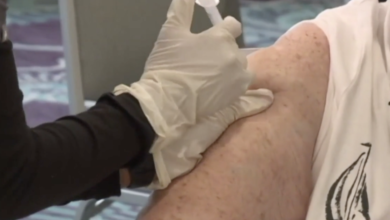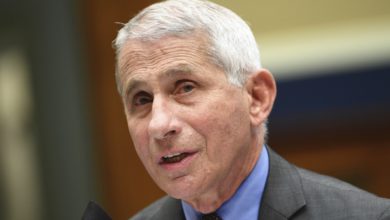
As the powerful surge in U.S. coronavirus case counts raises alarm, some experts are focusing instead on COVID-19 hospital admissions, which notably aren’t climbing as fast.
Dr. Anthony Fauci said Sunday that with many infections causing few or no symptoms, “it is much more relevant to focus on the hospitalizations as opposed to the total number of cases.”
Those hospital admissions averaged 14,800 per day last week, up 63% from the week before. That's still short of the peak of 16,500 per day a year ago when the vast majority of the U.S. was unvaccinated. Deaths have been stable over the past two weeks at an average of about 1,200 per day, well below the all-time high of 3,400 last January.
Other experts argue that case counts are still a cause for concern in their own right.
As the super-contagious omicron variant spreads across the U.S., new COVID-19 cases per day have more than tripled over the past two weeks, reaching a record-shattering average of 480,000. Schools, hospitals and airlines are struggling as infected workers go into isolation. Stresses to healthcare systems are exacerbating medical worker shortages, which have reached a critical point during the pandemic.
Public health experts suspect that lower hospitalization numbers reflect the vaccine’s continued effectiveness at preventing serious illness, even against omicron, as well as the possibility that the variant does not make most people as sick as earlier versions.
Dr. Wafaa El-Sadr, director of ICAP, a global health center at Columbia University, said the case count does not appear to be the most important number now.
Instead, she said, the U.S. should be “shifting our focus, especially in an era of vaccination, to really focus on preventing illness, disability and death, and therefore counting those.”
Also in the news:
► Starbucks says its U.S. workers must be fully vaccinated by Feb. 9 or face a weekly COVID testing requirement. The Seattle-based coffee giant said it was acting in response to the Occupational Safety and Health Administration, which issued a vaccine-or-test requirement for companies with more than 100 employees in November.
► A New York teacher was arrested after she injected a teenager with a COVID-19 vaccine, without the parents' consent, the Nassau County Police Department announced on Monday. Laura Parker Russo, 54, was charged with unauthorized practice of a profession, according to a news release.
📈Today's numbers: The U.S. has recorded more than 56 million confirmed COVID-19 cases – or one for every six people in the country – and more than 827,000 deaths, according to Johns Hopkins University data. Global totals: More than 292.6 million cases and 5.4 million deaths. More than 205.8 million Americans – 62% – are fully vaccinated, according to the CDC.
📘What we're reading: US coronavirus cases surge past previous records: How omicron is shaping the pandemic.
Keep refreshing this page for the latest news. Want more? Sign up for USA TODAY's free Coronavirus Watch newsletter to receive updates directly to your inbox and join our Facebook group.
Spring semester revving up online at many schools
A new year and the new strain of the coronavirus are resurrecting familiar problems for the nation’s millions of college students. Some universities have already decided to offer the first weeks of the spring semester virtually. And those offering an in-person start say digital instruction is still a possibility. What’s more, some that had rolled back COVID-19 precautions have reinstated those measures, such as the University of Alabama, which reintroduced its masking requirements.
Davidson College professor Chris Marsicano, who leads the College Crisis Initiative to study how colleges respond to the pandemic, says about 10% of the 400 major universities the group has reviewed so far plan to start online for the spring semester.
"This is not like last fall, where going online for a little bit could mean going online forever," he said. "All indications are that any delay or remote start will be followed up shortly thereafter by a return to normal operations."
–Chris Quintana
Chicago teachers vote for remote learning; no classes for 330K students
Teachers in the nation’s third-largest school district voted to switch to remote learning, prompting Chicago Public Schools to cancel Wednesday classes for its 330,000 students. The Chicago Teachers Union voted to pause in-person learning and work remotely until Jan. 18, or until COVID-19 cases fall below a particular threshold. The union, which has roughly 25,000 members, is also demanding the district require negative tests from students and staff before returning to school.
“This decision was made with a heavy heart and a singular focus on student and community safety,” the union said in a statement late Tuesday. Over the course of four hours late Tuesday, 73% of the union’s members voted in favor of shifting to remote learning.
In a news conference Tuesday night, Chicago Mayor Lori Lightfoot said the vote constituted an “illegal work action.” She said a shift back to virtual learning would disproportionately affect children of color. Teachers who do not show up will not be paid, Lightfoot said.
— Grace Hauck, USA TODAY
Tested positive for COVID-19? Do you need to isolate or quarantine?
Testing positive for COVID-19 starts a confusing, disruptive and at times frightening process – one that millions of Americans will likely go through in the coming weeks.
There is a difference between isolation and quarantine. Quarantine means keeping someone who was in close contact with someone who has COVID away from others. Isolation means keeping someone who is sick or tested positive for COVID-19 without symptoms away from others, even in their own home, according to the CDC.
If you are fully vaccinated you do not need to quarantine unless you have symptoms. But the CDC says isolating is a necessary step if you test positive whether you’re vaccinated or unvaccinated, and whether you have symptoms or feel fine.
The CDC in late December shortened the time it recommends people isolate, saying: "People with COVID-19 should isolate for 5 days and if they are asymptomatic or their symptoms are resolving (without fever for 24 hours), follow that by 5 days of wearing a mask when around others."
Read the CDC's updated guidance on isolating and quarantining.
Contributing: The Associated Press
Source link










